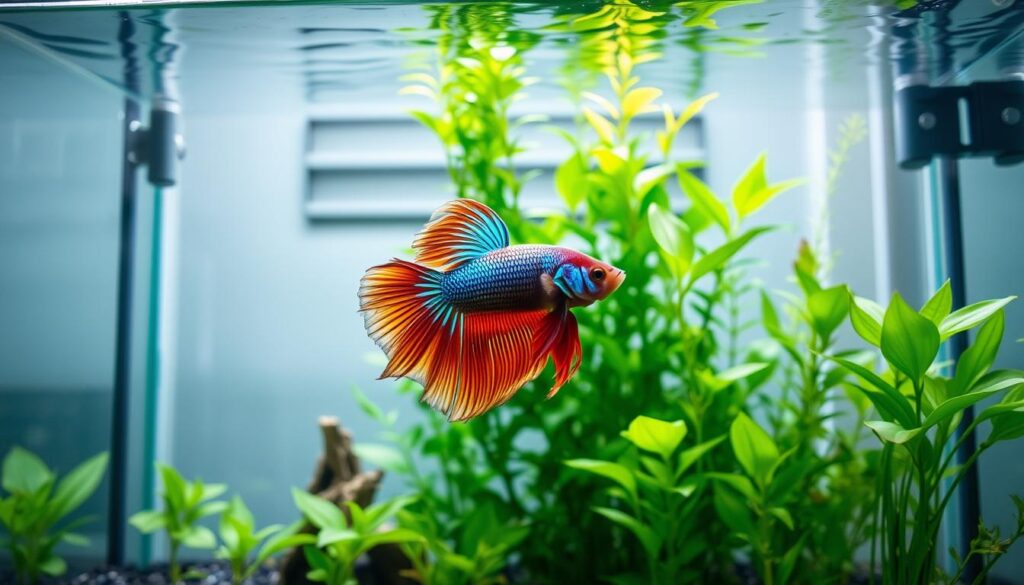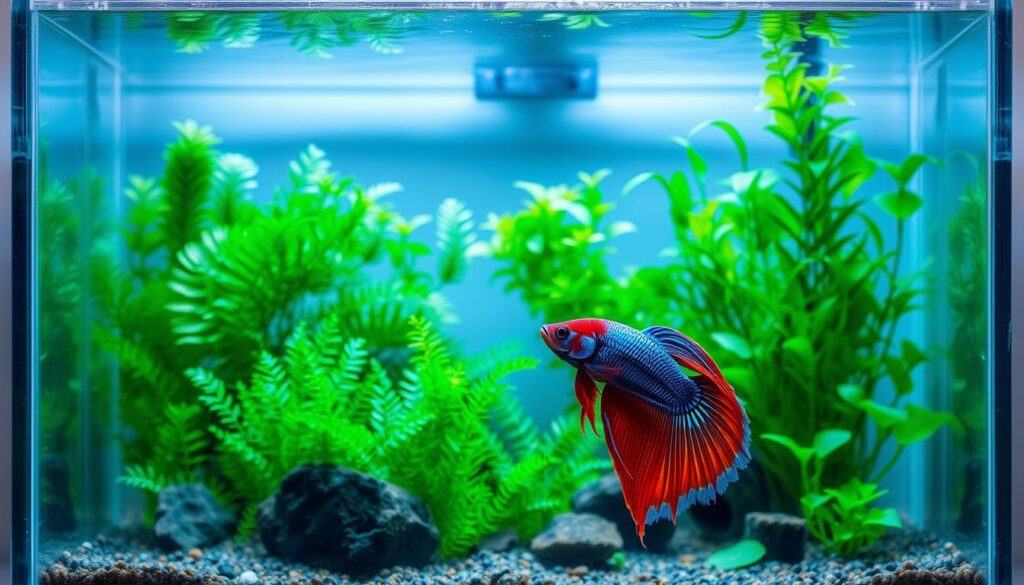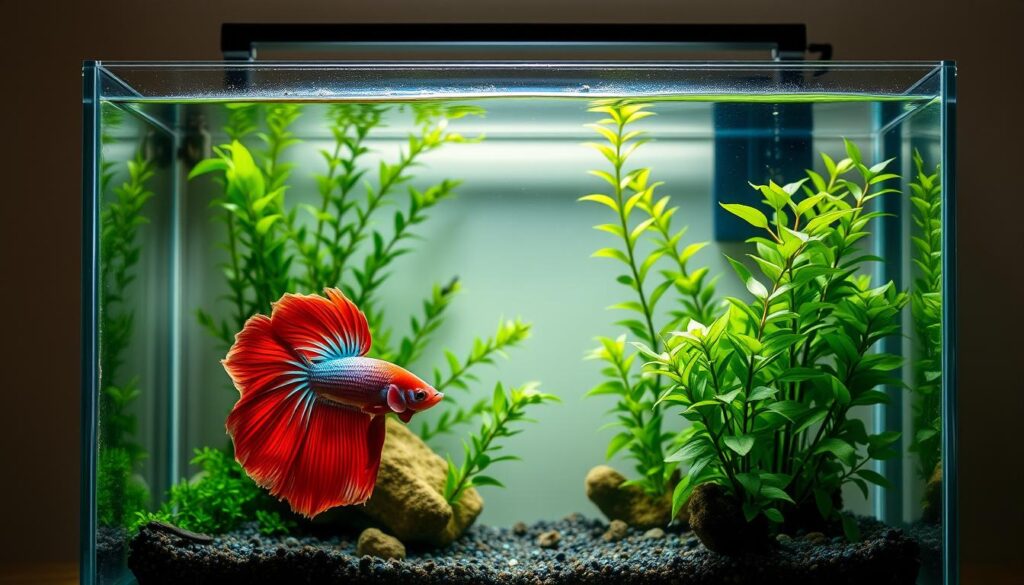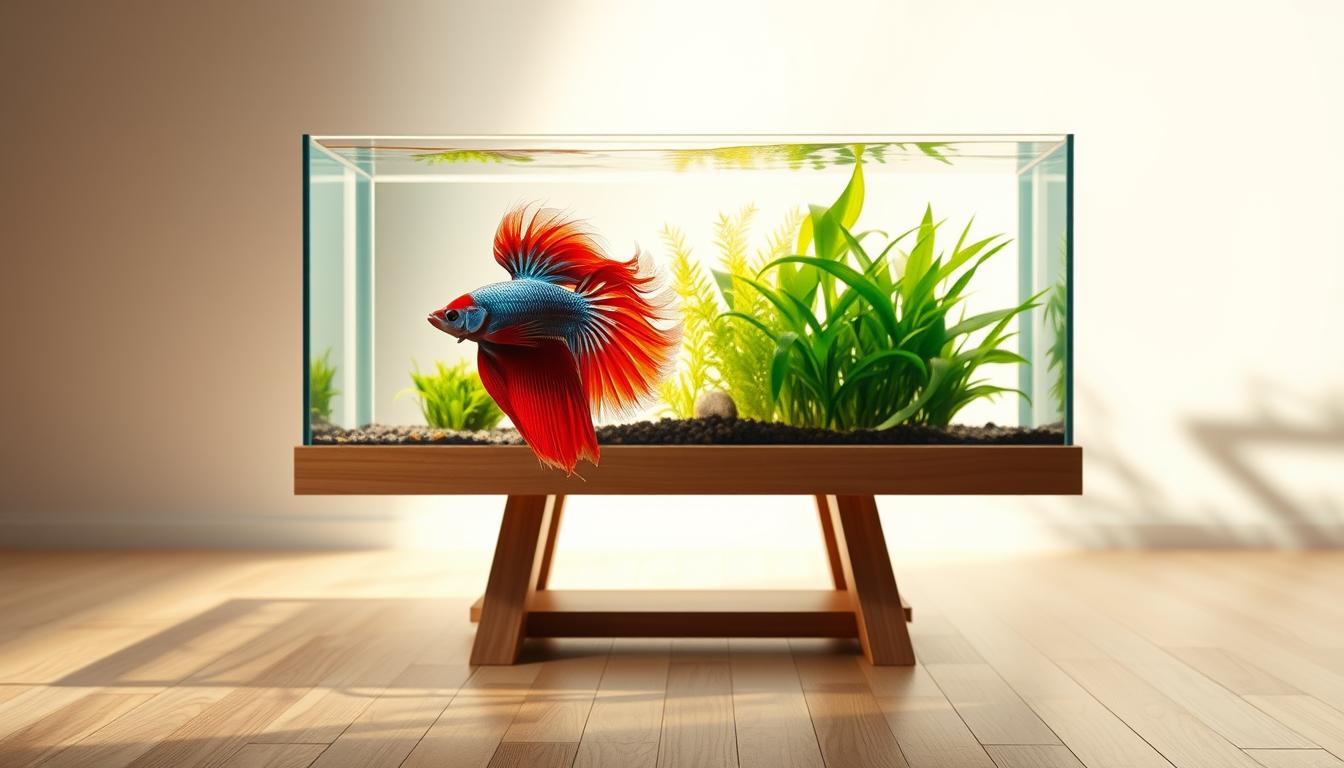If you’ve ever wondered what is a good size tank for a betta fish, you’re not alone. Many new betta owners mistakenly believe these vibrant fish can thrive in tiny bowls—but the truth is, they need space to swim, hide, and explore. Knowing what is a good size tank for a betta fish is essential for keeping your fish stress-free and healthy. In this article, we’ll explore the minimum tank size recommendations and why upgrading their environment can make a big difference in your betta’s life.
We’re here to help you navigate the world of betta fish care and find the ideal tank size for your finned friend. In this article, we’ll dive into the importance of tank size and explore the best options for your betta.
Key Takeaways
- The ideal tank size for betta fish is a topic of ongoing debate.
- Choosing the right tank size is crucial for your betta’s health and well-being.
- A suitable tank size can help prevent health problems in betta fish.
- We’ll explore the pros and cons of different tank sizes for betta fish.
- Our expert advice will help you make an informed decision for your betta’s home.
Understanding Betta Fish Habitat Needs
The natural environment of betta fish is a fascinating topic that can inform our tank choices. Betta fish, or Betta splendens, are native to the shallow, slow-moving waters of Southeast Asia, particularly in countries like Thailand and Cambodia.
Natural Environment of Betta Fish
In their natural habitat, betta fish inhabit densely vegetated areas, including rice paddies, marshes, and slow-moving streams. These environments are characterized by warm, slightly acidic to neutral water, with temperatures ranging from 76°F to 82°F (24°C to 28°C).
The water in these areas is often calm or slow-moving, which is quite different from the fast-flowing rivers or deep lakes. This calm environment allows betta fish to thrive and exhibit their natural behaviors.
Why Habitat Matters for Captive Bettas
Replicating the natural habitat of betta fish in captivity is crucial for their health and wellbeing. Here are some key reasons why:
- Water conditions: Matching the water parameters of their natural habitat helps reduce stress and promotes health.
- Space and vegetation: Providing adequate space with plants and hiding spots allows betta fish to exhibit natural behaviors.
- Tank size: A larger tank with stable water conditions is generally better for betta fish, contrary to the common belief that they thrive in small containers.
As aquarium expert Dr. Chris Andrews once said,
“The key to keeping betta fish healthy is to replicate their natural environment as closely as possible.”
This involves not just the right tank size, but also appropriate water conditions and decorations that mimic their natural habitat.
By understanding and replicating the natural habitat needs of betta fish, you can make informed decisions about betta fish tank recommendations and choose the best tank size for betta fish to ensure their optimal health.
The Myth of Small Bowls and Cups
The idea that betta fish can survive in small cups is a myth that’s been perpetuated for far too long, and it’s time to set the record straight! Many of us have seen betta fish sold in tiny containers, leading to the misconception that they’re perfectly happy in such small spaces. But, we’re here to tell you that’s not the case.
Common Misconceptions About Betta Housing
One of the most common misconceptions about betta fish is that they’re low-maintenance pets that can thrive in tiny environments. While it’s true that betta fish can survive in small spaces for short periods, it’s not a suitable long-term solution. In fact, keeping your betta in a small bowl or cup can be detrimental to its health.
Why Small Containers Are Harmful
Small containers lack the stability that larger tanks provide. Water parameters can fluctuate rapidly, stressing your betta and making it more susceptible to disease. “A small tank is like a tiny kitchen – it’s hard to keep everything in order,” says a renowned aquarist. Moreover, small spaces limit your betta’s ability to swim and exercise, leading to a sedentary lifestyle.
The Real Impact on Betta Health
So, what’s the real impact on betta health? Keeping your betta in a small container can lead to a range of health issues, from fin rot to fungal infections. In contrast, a larger tank provides a stable environment, reducing stress and promoting overall health. By choosing the right betta fish tank size, you’re giving your pet the best chance at a happy, healthy life.
When it comes to choosing a betta fish tank size, it’s essential to consider the recommended tank size for betta fish. A larger tank isn’t just a luxury – it’s a necessity for providing your betta with the quality of life it deserves.
Read Also How Many Betta Fish in a 10 Gallon Tank? Tips You Need to Know!
What Is a Good Size Tank for a Betta Fish?
When it comes to housing your betta fish, the size of the tank is crucial for their health and happiness. So, what is a good size tank for a betta fish? The answer might surprise you!
Minimum Tank Size Requirements
The minimum tank size recommended for betta fish is a topic of much debate. While some argue that a small tank is sufficient, experts suggest that a minimum of 5 gallons is ideal. This size tank provides a stable environment and gives your betta enough space to swim.
Here are some key considerations for minimum tank size:
- Water stability: Larger tanks are more stable in terms of water parameters.
- Swimming space: Bettas need room to swim and exercise.
- Equipment: Larger tanks can accommodate better filtration and heating systems.
Recommended Tank Sizes for Optimal Health
While the minimum tank size is 5 gallons, the recommended size for optimal health is often considered to be 10 gallons or more. A study found that the average territory per wild betta fish was about 11 gallons, suggesting that larger tanks are more suitable.
| Tank Size | Benefits |
|---|---|
| 5 gallons | Minimum recommended size; stable environment. |
| 10 gallons | Ideal for optimal health; ample swimming space. |
Scientific Evidence Supporting Larger Tanks
Research supports the idea that larger tanks are better for betta fish. As mentioned in a study, the natural habitat of betta fish is quite spacious, indicating that they thrive in larger environments.
“The natural habitat of betta fish is characterized by large areas of water with ample hiding places and swimming space.” –
So, if you’re looking to give your betta the best life possible, consider upgrading to a larger tank. Your betta will thank you!
Benefits of Larger Tanks for Bettas
Larger tanks offer numerous benefits for betta fish, from improved water quality to increased swimming space. When you provide your betta with a spacious environment, you’re giving them the best chance at a happy and healthy life.
Water Quality Stability
One of the primary advantages of a larger tank is the stability it offers in terms of water quality. With more water volume, parameters are less likely to fluctuate wildly, creating a more stable environment for your betta. This stability is crucial for your fish’s overall health and well-being.
Swimming Space and Exercise
Betta fish are natural swimmers and need room to exercise. A larger tank provides the space they need to move around, promoting physical health and reducing the risk of boredom and stress. Ample swimming space is essential for maintaining your betta’s health and vitality.

Behavioral Enrichment Opportunities
Larger tanks also offer opportunities for behavioral enrichment. You can create a varied environment with plants, decorations, and other features that stimulate your betta’s natural behaviors. This enrichment is key to keeping your betta engaged and active.
By choosing a larger tank for your betta, you’re investing in their long-term health and happiness. Consider the benefits of a spacious environment, and you’ll be well on your way to creating a thriving aquatic home for your pet.
Tank Size Impact on Betta Health and Lifespan
The tank size you choose for your betta fish can significantly impact their overall health and lifespan. A suitable tank size is not just about providing enough space; it’s about creating an environment that promotes well-being and reduces the risk of disease.
Stress Reduction in Appropriate Sized Tanks
A tank that is too small can cause significant stress to your betta fish. Stress can lead to a weakened immune system, making your betta more susceptible to illness. On the other hand, a spacious tank helps to reduce stress by providing ample swimming room and stable water conditions. You can further reduce stress by adding plants and decorations that create hiding places and visual barriers.
Read Also Betta Fish Food Guide: Optimal Feeding Amounts
Disease Prevention Through Proper Housing
Proper tank size is crucial for preventing disease in betta fish. In smaller tanks, water parameters can fluctuate wildly, leading to conditions that foster disease. Larger tanks, however, tend to have more stable water conditions, reducing the risk of disease. Regular water changes and proper filtration also play a key role in maintaining a healthy environment.
Signs Your Betta Needs a Larger Tank
So, how do you know if your betta needs a larger tank? Look out for signs such as lethargy, loss of appetite, or frequent surface breathing. If you notice any of these symptoms, it may be time to upgrade to a larger tank. Additionally, if your tank is frequently experiencing water parameter swings, it’s a sign that the tank is too small for your betta’s needs.
| Tank Size | Water Stability | Betta Health |
|---|---|---|
| Less than 2.5 gallons | Unstable | High risk of disease |
| 2.5-5 gallons | Moderately stable | Moderate risk |
| More than 5 gallons | Very stable | Low risk of disease |
By choosing the right tank size for your betta fish, you can significantly improve their quality of life and lifespan. Remember, a happy betta is a healthy betta!
Setting Up a 2.5 to 3-Gallon Betta Tank
Creating a suitable habitat in a 2.5 to 3-gallon tank requires some careful planning! While these smaller tanks can be more challenging to maintain than larger ones, they can still provide a healthy environment for your Betta fish with the right setup.
Pros and Cons of Smaller Setups
Smaller tanks have their advantages and disadvantages. On the plus side, they are often more affordable and take up less space, making them ideal for those living in small apartments or on a budget. However, they can be more sensitive to water parameter changes, requiring more frequent monitoring.
Key Considerations:
- More frequent water changes
- Careful selection of equipment
- Monitoring water parameters closely
Essential Equipment for Small Tanks
For a 2.5 to 3-gallon tank, you’ll need a heater to maintain a stable temperature, a filter that’s appropriate for the tank size, and lighting that’s not too intense. “A good rule of thumb is to choose a filter that is rated for at least twice the volume of your tank,” says aquatic expert, Dr. James Findlay.
“The key to a healthy Betta is a stable environment. In smaller tanks, this means being vigilant about water quality and temperature.”
Maintenance Requirements
Regular maintenance is crucial in smaller tanks. This includes weekly water changes of about 25-50% and regular cleaning of the gravel and decorations. By staying on top of maintenance, you can keep your Betta healthy and thriving.
By understanding the pros and cons and being diligent about maintenance, you can create a wonderful home for your Betta in a 2.5 to 3-gallon tank!
Setting Up a 5-Gallon Betta Tank
A 5-gallon tank is frequently recommended for betta fish, and for good reason – it offers a great balance between stability and space. When setting up a 5-gallon tank, you’re not just creating a home for your betta; you’re crafting an underwater world that can thrive with the right equipment and design.
Why 5 Gallons Is Often Recommended
A 5-gallon tank provides a stable environment for your betta fish. The larger volume of water helps to dilute waste products, making it easier to maintain good water quality. Additionally, it gives your betta ample space to swim and exercise, which is crucial for their health and happiness.
As noted by aquatic experts, “A larger tank doesn’t just benefit the fish; it makes tank maintenance easier for the owner.” This is particularly true for a 5-gallon tank, where water parameters are more stable, and there’s less chance of sudden changes that can stress your betta.
Essential Equipment for a 5-Gallon Setup
To set up a thriving 5-gallon betta tank, you’ll need some essential equipment. Here’s a rundown of what you’ll need:
- A good quality aquarium filter to keep the water clean
- A heater to maintain a comfortable temperature for your betta
- Lighting that’s not too harsh for your betta’s eyes
- A thermometer to monitor the water temperature
- Decorations and plants to provide hiding places and visual stimulation
| Equipment | Purpose | Recommendation |
|---|---|---|
| Filter | Water Circulation and Purification | Adjustable Flow Filter |
| Heater | Maintaining Optimal Temperature | Submersible Heater with Thermostat |
| Lighting | Enhancing Visual Appeal | Low-Wattage LED Light |
Ideal Layout and Decorations
Creating an ideal layout for your 5-gallon betta tank involves more than just adding some decorations. You need to think about creating a comfortable environment that mimics your betta’s natural habitat.
Creating a Comfortable Environment
To create a comfortable environment, consider adding plants like Java Moss or Anubias that are easy to care for and provide great hiding spots for your betta. You can also add decorations such as treasure chests or sunken ships to give your betta places to explore.
Remember, the key is to strike a balance between decoration and open swimming space. Your betta will appreciate having places to hide and feel secure, but they also need room to swim.
By following these guidelines, you can create a beautiful and thriving 5-gallon betta tank that will be a joy to behold and a happy home for your betta fish.
Setting Up a 10-Gallon or Larger Betta Tank
A 10-gallon or larger tank offers a world of possibilities for creating an ideal environment for your betta fish! With more space, you can get creative with tank layouts and decorations, providing your betta with a stimulating and varied home.
Benefits of Larger Setups
Larger tanks come with numerous benefits for both you and your betta. For one, they offer greater water volume, which means more stability in water parameters and less frequent water changes. This stability is crucial for your betta’s health and well-being.
Another advantage is the ability to incorporate a variety of equipment, such as heaters, filters, and lighting, to create a comfortable and thriving environment. You can also add more decorations and plants, which not only beautify the tank but also provide hiding places and visual stimulation for your betta.
Creating Zones in Larger Tanks
In a larger tank, you can create different zones or areas for your betta to explore. This can include a planted area with live plants, an open swimming zone for exercise, and a hiding cave or two for your betta to retreat to when it feels stressed or needs some alone time.
| Zone | Purpose | Decorations |
|---|---|---|
| Planted Area | Provides hiding places and visual stimulation | Live plants like Java Moss or Anubias |
| Open Swimming Zone | Encourages exercise and swimming | Minimal decorations, open space |
| Hiding Caves | Reduces stress, provides security | Caves, rocks, or driftwood |

By thoughtfully designing these zones, you can create a dynamic and engaging environment that meets your betta’s physical and psychological needs. So, get creative and have fun setting up your 10-gallon or larger betta tank!
Tank Mates and Community Setups
If you’re considering a community tank for your betta, you’ll need to think carefully about the tank size and the other fish you’ll be keeping with it. While betta fish are often kept alone, they can thrive in community environments with the right tank mates and setup.
Minimum Tank Size for Betta Community Tanks
For community setups, a minimum tank size of 10 gallons is recommended. This larger tank size provides a more stable environment and gives you the space to create separate areas for your betta and its tank mates. A 10-gallon tank also allows for a better balance of water parameters, reducing the risk of stress and disease in your fish.
Compatible Tank Mates Based on Tank Size
When choosing tank mates for your betta, it’s essential to select fish that are compatible and won’t harass or compete with your betta for food or territory. For a 10-gallon tank, consider peaceful, small-schooling fish like neon tetras or harlequin rasboras. In larger tanks (20 gallons or more), you can introduce other compatible species like corydoras catfish or dwarf gouramis.
Creating Safe Spaces in Shared Tanks
To keep your betta safe and happy in a community tank, you’ll need to create separate areas or “safe spaces” where it can retreat if feeling threatened or territorial. This can be achieved by adding plants, rocks, or decorations that provide hiding places and visual barriers. By creating these safe spaces, you can reduce stress and promote a harmonious community environment.
By choosing the right tank size and tank mates, and by creating a well-designed environment, you can enjoy a thriving community tank with your betta fish as the centerpiece.
Upgrading Your Betta’s Tank Size
As your betta fish grows and thrives, you might need to consider upgrading its tank size for a happier, healthier life! A larger tank can provide a more stable environment, reduce stress, and give your betta room to swim and exercise.
Read Also Betta Fish Spitting Food? Causes & Fixes
Signs It’s Time to Upgrade
So, how do you know when it’s time to level up your betta’s living arrangements? Look out for these key signs: poor water quality, stress indicators like lethargy or loss of appetite, and visible signs of discomfort such as fin nipping or rubbing against decorations.
- Frequent water changes are becoming a chore
- Your betta is consistently showing signs of stress
- The tank is overcrowded or lacks hiding places
Step-by-Step Tank Transfer Process
Upgrading your betta’s tank doesn’t have to be daunting. Here’s a simple step-by-step guide:
- Prepare the new tank by setting it up and cycling it before introducing your betta.
- Transfer your betta to a temporary container filled with water from its current tank.
- Float the container in the new tank to acclimate your betta to the new water conditions.
- Gently release your betta into its new home.
Acclimating Your Betta to a Larger Space
After the transfer, monitor your betta closely. It may take some time for it to explore and claim its new territory. Ensure there are plenty of hiding places and plants to make it feel secure. With patience and proper care, your betta will thrive in its new environment!

Common Challenges with Different Tank Sizes
Different tank sizes present different challenges for betta fish owners, from water quality issues to space constraints. Whether you’re opting for a compact tank or a spacious aquarium, understanding these challenges is key to providing the best care for your betta.
Managing Small Tank Issues
Small tanks, typically those under 5 gallons, can be challenging to maintain due to their limited water volume. Water quality can fluctuate rapidly, and even small changes can be detrimental to your betta’s health. Regular water changes and careful monitoring are crucial!
Addressing Large Tank Challenges
On the other hand, larger tanks, while offering more stability, come with their own set of challenges. Space and equipment costs can be significant, and ensuring that your betta has enough space and appropriate environments within the tank is vital.
Finding the Right Balance
So, how do you strike the right balance? It’s about understanding your betta’s needs and being aware of the potential challenges associated with your chosen tank size. By doing so, you can create a thriving environment that supports your betta’s health and happiness.
Conclusion
We’ve explored the ins and outs of choosing the right tank size for your betta fish, and it’s clear that the ideal environment is a balance between stable water parameters and ample space for your betta to thrive. When considering betta fish tank recommendations, it’s essential to prioritize your pet’s health and happiness.
The best tank size for betta fish isn’t a one-size-fits-all answer, but we’ve seen that a minimum of 5 gallons is often recommended tank size for betta fish. This size provides the necessary stability in water quality and gives your betta room to swim and exercise. Whether you’re setting up a small 2.5-gallon tank or a spacious 10-gallon or larger aquarium, the key is to create a comfortable and stimulating environment.
By choosing the right tank size and setting it up correctly, you’re not just giving your betta a home – you’re giving them a happy, healthy life. So, take the time to research, plan, and enjoy the journey of creating a thriving aquatic world for your beloved pet!

